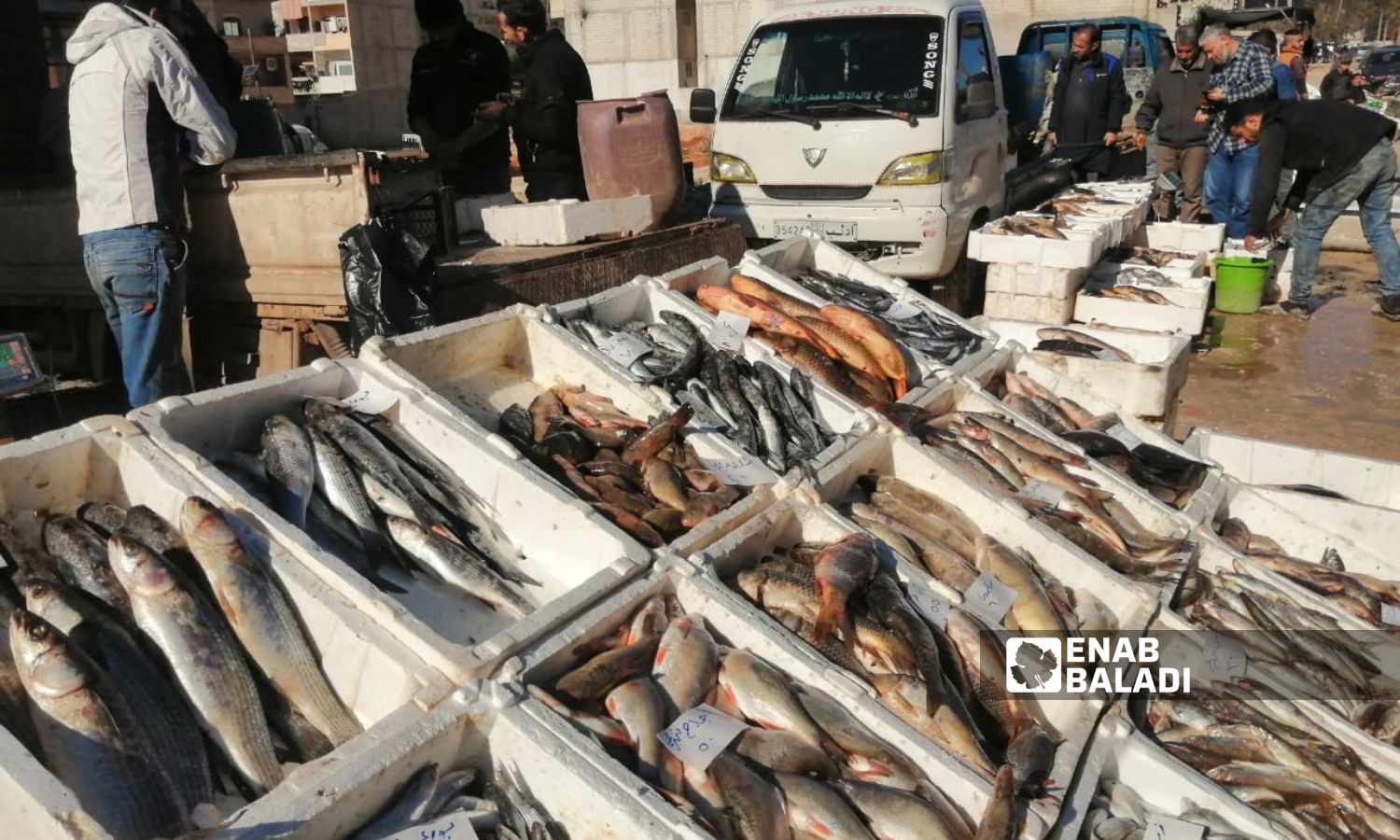



Idlib – Shams al-Din Matoun
Meat prices in Idlib province, both white meat represented by chicken and red meats from sheep, mutton, and veal, continue to rise, making them an unavailable option for most residents, especially with decreasing purchasing power.
In contrast, fish markets are witnessing a good turnout as their meat provides high nutritional value and is sold at acceptable prices compared to other types of meat.
The weekly popular markets (bazaars) spread throughout Idlib serve as a place to sell fish at lower prices than specialized stores.
According to Mohammed al-Ali, a fish vendor in Kafr Takharim bazaar, the low prices do not mean a decline in quality. He points out that shops sell at higher prices due to their additional expenses, such as rent, workers’ wages, and fish packaging.
“The fish is fresh, come closer, o poor man, come see,” with this phrase, al-Ali calls attention to his goods, noting that he provides most kinds of fish available in shops at a lower price through his roaming vehicles.
The quality and type of fish meat vary according to its growing environment: marine, riverine, or from fish farms. Marine fish come to Idlib markets via the Bab al-Hawa border crossing with Turkey, with Turkish-origin fish available in multiple varieties including “Salmon, Gilt-head bream, Bayraktar, Mullet, Tilapia,” among others.
The market also provides river fish that come from areas in northern rural Aleppo, originating from the Euphrates River, with “Carp” being the most famous type.
In small quantities, fish caught from the Orontes River in the Darkush area west of Idlib are also available, as well as fish bred in local facilities with various types like Catfish and Carp.
Adham Halaq, a resident of the city of Binnish east of Idlib, regularly visits the fish market held in his city every Tuesday and is accustomed to buying various kinds of fish.
Halaq says he now primarily relies on fish meat, using it to cook a variety of dishes, adding, “We make a meat dish in a tray after finely grinding the fish, and also cook it with rice.”
He mentioned that the decrease in fish market prices has allowed him to consume varieties that are sold at higher prices in stores, such as Bream and Salmon.
According to what Enab Baladi observed, fish prices in the market are not significantly affected by the exchange rate of the US dollar or by increased demand but are affected by the decrease in quantities imported through the Bab al-Hawa crossing, especially as there was a decline during the end-of-year holidays.
On the streets of Idlib, many fish merchants roam with cars loaded with inexpensive fish of various types, the most famous being Carp, Bream, and Sardines.
Amjad Darkushy, a roaming fish seller, told Enab Baladi that prices drop in the post-noon period as the market closure approaches, adding that he is forced to sell at lower prices trying to sell off the entire quantity, as most vendors do not have suitable places to store fish.
The seller mentioned that despite the rise, fish prices are still low compared to other types of meat, pointing out that the price of the best varieties he has does not exceed 100 Turkish liras, which is “Sea Bream.”
The prices of the remaining varieties range from 35 to 100 Turkish liras (1 US dollar equals 29.5 Turkish lira).
Enab Baladi has viewed a list with the prices of the most popular varieties sold in Idlib’s fish markets, where a kilogram of Sea Bream is priced at 80 liras, Regular Bream at 60 liras, Bayraktar at 45 liras, Salmon at 70 liras, a kilogram of Sardines at 50 liras, Carp at 40 liras, Tilapia at 59 liras, and a kilogram of Catfish at 60 Turkish liras.
The price per kilogram of sheep meat is 340 Turkish liras, mutton meat is 320 liras, and veal meat ranges between 210 and 270 liras, with a kilogram of chicken breast priced at 80 liras, and other parts ranging between 45 and 70 liras.
Daily wages in the Idlib region range between 60 and 100 Turkish liras (an average of three dollars), varying according to the number of working hours and the nature of the profession, whether in agriculture, manual labor, or construction work.
if you think the article contain wrong information or you have additional details Send Correction